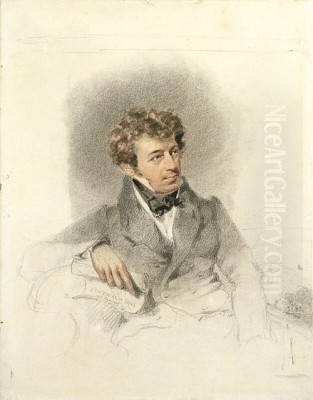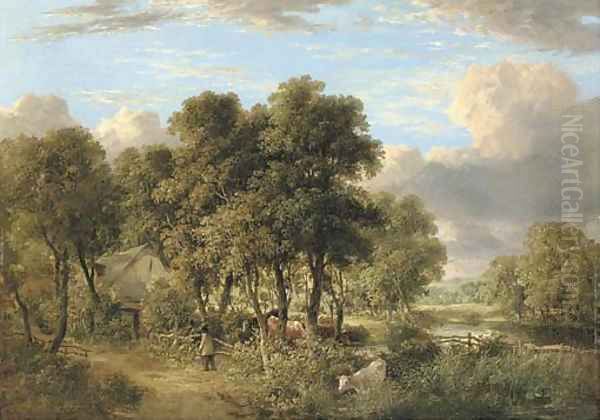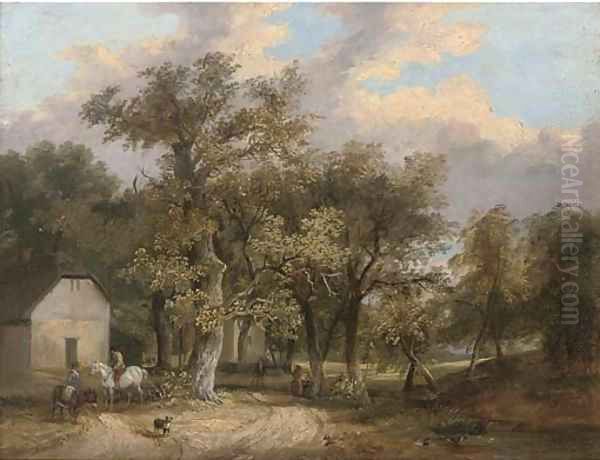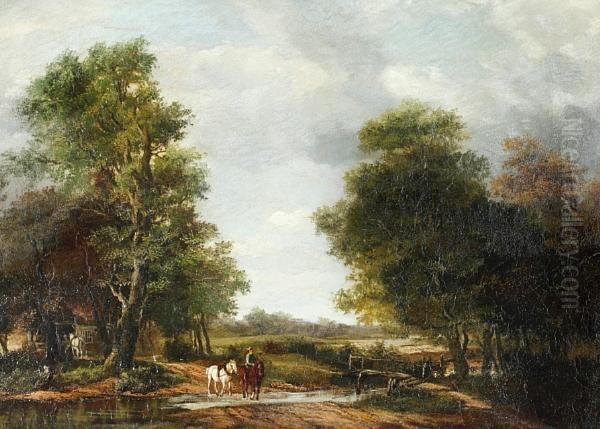
James Stark stands as a significant figure within the celebrated Norwich School of painters, the first provincial art movement to flourish in Britain. Born in Norwich on November 19, 1794, he dedicated much of his artistic career to capturing the subtle beauties of the Norfolk landscape, contributing a distinct voice to the collective vision of his contemporaries. Though perhaps sometimes overshadowed by the founding figures of the school, Stark's meticulous observation and gentle portrayal of nature earned him a respected place in nineteenth-century British art.
Early Life and Artistic Awakening in Norwich
James Stark's origins were rooted in Norwich, a city that would become synonymous with his artistic identity. His father, Michael Stark, was a dyer who had relocated from Scotland, establishing a life in the bustling East Anglian centre. From an early age, James displayed a clear aptitude and passion for art. He received his initial education within Norwich, where the seeds of his future career were sown.
The most formative influence on the young Stark was undoubtedly John Crome (1768-1821), often referred to as 'Old Crome' to distinguish him from his artist son. Crome was a towering figure in Norwich, a co-founder of the Norwich Society of Artists in 1803, and a painter whose deep love for the local landscape, heavily inspired by Dutch Golden Age masters, set the tone for the entire school. From 1811 to 1814, Stark served as an articled pupil to Crome, absorbing not only technical skills but also Crome's philosophy of direct observation and truthful representation of the natural world.
During his apprenticeship, Stark quickly integrated into the local artistic community. In 1812, while still under Crome's tutelage, he became a member of the Norwich Society of Artists. This society provided a crucial platform for local artists to exhibit their work, share ideas, and foster a collective identity distinct from the London-centric art establishment. Exhibiting alongside Crome and other members like John Sell Cotman, Robert Ladbrooke, and George Vincent would have been an invaluable experience for the young painter.
London Studies and Early Recognition

Seeking broader horizons and further refinement of his skills, Stark made the pivotal decision to move to London in 1814. The capital offered access to major institutions, influential artists, and a wider audience. Soon after his arrival, he formed a significant friendship with the painter William Collins (1788-1847). Collins, known for his coastal scenes and rustic genre subjects, became a friend and his work likely exerted some influence on Stark's developing style, perhaps encouraging an interest in coastal themes alongside the inland landscapes favoured by Crome.
Stark's ambition led him to enroll at the prestigious Royal Academy Schools in 1817. Studying at the Academy provided rigorous training in drawing and painting, exposure to the works of established masters, and the opportunity to compete for recognition. He began exhibiting his works, not only at the Royal Academy itself from a young age but also at the British Institution, another important London venue. His talent was formally acknowledged in 1818 when he won a significant prize of £50 from the British Institution, a considerable boost for a young artist establishing his reputation.
However, Stark's time as a full-time student in London was curtailed by ill health. After approximately two years at the Royal Academy Schools, persistent health problems forced him to leave the demanding environment of the capital and return to his native Norwich around 1819. This return marked a new phase in his career, redirecting his focus firmly back to the landscapes of Norfolk.
The Norwich School Context
To fully appreciate James Stark's contribution, it is essential to understand the context of the Norwich School. Emerging in the early nineteenth century, it was unique in being a cohesive art movement based outside London. Its members shared a common inspiration: the distinctive landscape of Norfolk, with its meandering rivers, expansive heathlands, ancient woodlands, and dramatic coastline. They drew heavily on the tradition of seventeenth-century Dutch landscape painters, particularly Meindert Hobbema and Jacob van Ruisdael, admiring their naturalism, detailed observation, and mastery of light and atmosphere.
John Crome and John Sell Cotman (1782-1842) are generally considered the leading figures of the school. While Crome's work emphasized robust naturalism and earthy textures, Cotman developed a more stylized approach, characterized by simplified forms, flat planes of colour, and elegant compositions, particularly in his watercolours. Stark, emerging as part of the generation following Crome, absorbed these influences but forged his own path.

Other notable members included George Vincent (1796-c.1832), a close friend and fellow pupil of Crome whose promising career was cut short; Joseph Stannard (1797-1830), known for his marine paintings and river scenes; John Thirtle (1777-1839), primarily a watercolourist; and later figures who carried the tradition forward. Stark, alongside Vincent, played a crucial role in continuing the school's landscape focus after Crome's death in 1821.
Artistic Style: Detail, Truth, and Quietude
James Stark's artistic style is characterized by its meticulous attention to detail, a commitment to capturing the specific textures and forms of nature, and an overall sense of gentle quietude. While clearly influenced by his master, John Crome, and the Dutch landscape tradition, Stark generally avoided the broader handling and sometimes dramatic compositions favoured by Crome. His canvases are often more intimate in scale and mood.
His preferred subjects were the woodlands, riverbanks, and heathlands of Norfolk. He excelled at depicting the intricate patterns of tree branches and foliage, the play of sunlight filtering through leaves, and the calm surfaces of water reflecting the surrounding scenery. His work demonstrates a "gentle truth," a faithful rendering of the observed world without excessive romanticization, yet imbued with a palpable affection for the locality. The influence of Dutch masters like Hobbema is evident in his detailed rendering of trees and rustic buildings.
Compared to the dramatic atmospheric effects pursued by contemporaries like J.M.W. Turner (1775-1851) or the scientific observation of light and weather seen in the work of John Constable (1776-1837), Stark's vision was more contained and focused. His compositions are typically well-structured, often featuring winding paths or rivers leading the viewer's eye into the scene. His colour palette tends towards naturalistic greens and browns, capturing the specific tones of the East Anglian landscape.
Stark worked proficiently in both oil and watercolour, and his preparatory sketches and drawings reveal a careful and observant eye. His technique involved precise drawing and the careful application of paint to build up detailed surfaces. While some critics have occasionally found his style somewhat formulaic or repetitive compared to the innovations of Crome or Cotman, his best works possess a distinct charm and technical accomplishment.
Mature Career: The Rivers of Norfolk and Coastal Scenes

Following his return to Norwich around 1819, Stark fully immersed himself in painting the local scenery. This period saw the conception and execution of one of his most significant projects: Scenery of the Rivers of Norfolk. Published between 1827 and 1834, this series comprised thirty-six engravings made by various artists (including Edward Goodall, George Cooke, and William Miller) based on Stark's paintings. The work celebrated the picturesque beauty of the rivers Yare, Waveney, and Bure, showcasing tranquil riverbanks, windmills, boats, and waterside villages. It was a major undertaking that cemented Stark's reputation as a leading interpreter of the Norfolk landscape.
While primarily known for his inland scenes, Stark also turned his attention to the coast. His painting The Fish Auction, Yarmouth (1827) is a notable example. As mentioned in the initial source material, such works not only depicted the physical environment of the coast but could also carry elements of social observation, capturing aspects of daily life and commerce in coastal communities like Great Yarmouth. This demonstrates a breadth of interest beyond purely pastoral landscapes.
Throughout the 1820s and beyond, Stark continued to produce numerous views of Thorpe, Postwick Grove, Whitlingham, and other familiar locations around Norwich. Woodland glades, sandy lanes bordered by Gorse, and quiet stretches of river remained favourite motifs. His dedication to these subjects provided a valuable visual record of the Norfolk countryside during a period of gradual change.
Later Life, Legacy, and Reputation
Around 1830, James Stark decided to relocate once more, moving back to London. He continued to paint and exhibit, maintaining his connections with the art world. During this period, he took on Henry John Jutsum (1816-1869) as a pupil or apprentice. Jutsum would go on to become a successful landscape painter in his own right, initially working in a style clearly influenced by Stark and the Norwich School tradition before developing his own manner.
Stark had married Elizabeth Younge, and they settled in London, where he spent the remainder of his life. He continued to exhibit his works regularly at institutions like the Royal Academy and the British Institution. He passed away in London on March 24, 1859.
James Stark's legacy is primarily secured through his significant role within the Norwich School. He was a dedicated and skilled painter who faithfully upheld the school's core tenets of landscape painting based on direct observation and influenced by Dutch naturalism. His Scenery of the Rivers of Norfolk remains a landmark publication celebrating the region's beauty.
His reputation, however, has sometimes been debated. While acknowledged as an important member of the school, he is often placed secondary to the more innovative or powerful talents of John Crome and John Sell Cotman. Some art historians have noted a degree of variability in the quality of his output, and occasionally works have been debated regarding attribution between Stark and his master, Crome. Despite this, his best paintings are highly regarded for their technical skill, detailed observation, and serene depiction of the English countryside.
Today, James Stark's works are held in numerous public collections, most notably the Norwich Castle Museum & Art Gallery, which houses the world's premier collection of Norwich School paintings. His art can also be found in major institutions such as Tate Britain, the Victoria and Albert Museum in London, and various regional galleries throughout the United Kingdom and internationally, ensuring his contribution to British landscape painting continues to be appreciated. He remains a key figure for understanding the depth and character of the Norwich School and its unique place in art history.